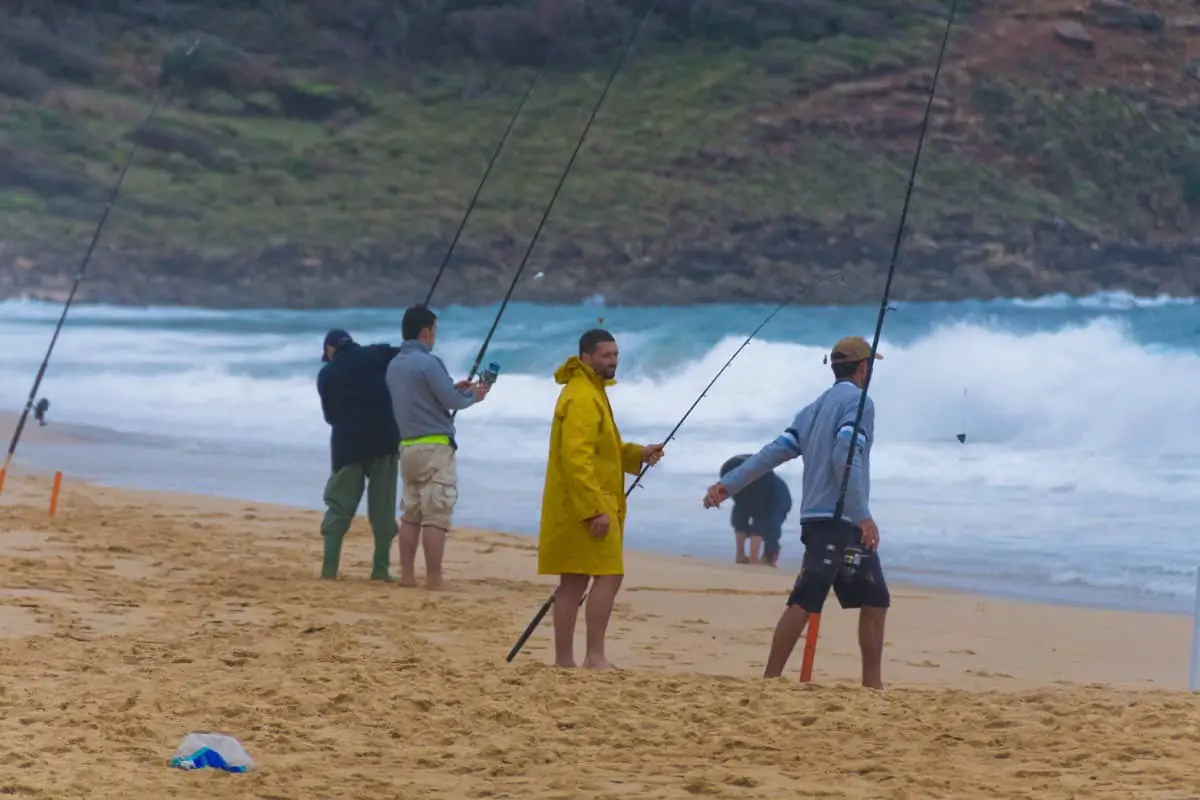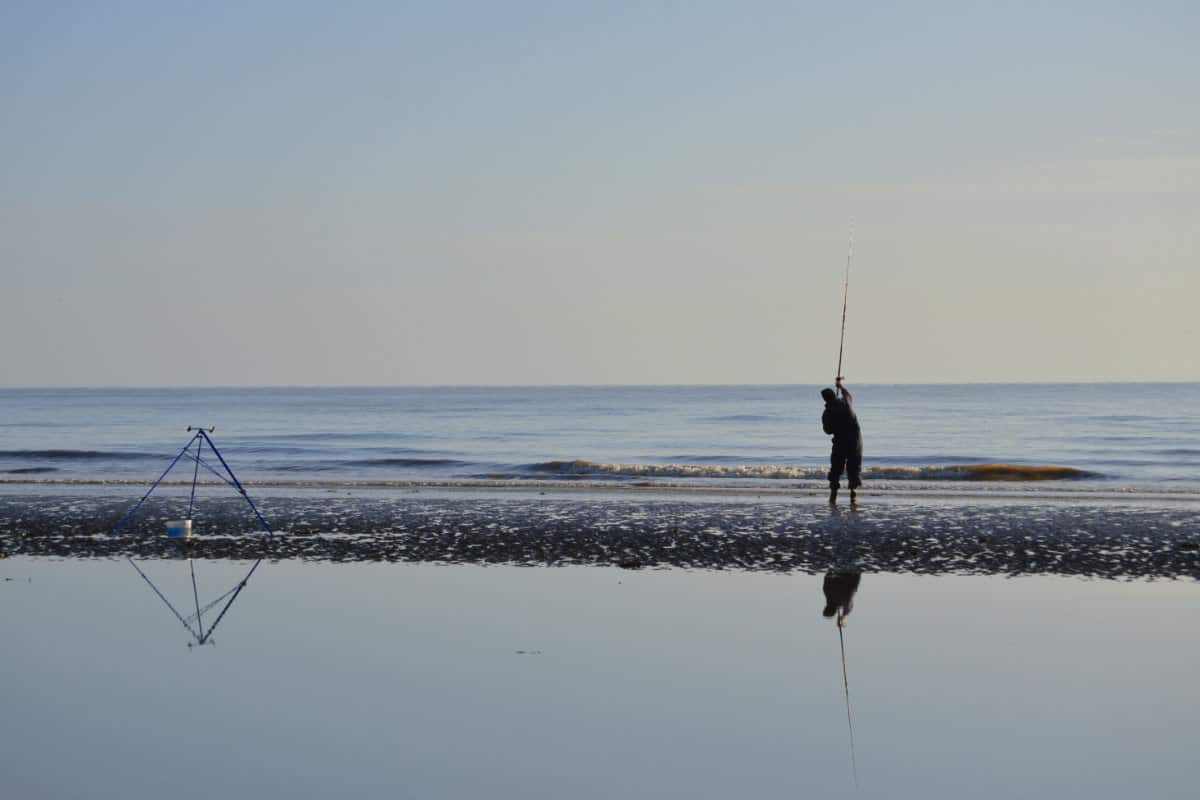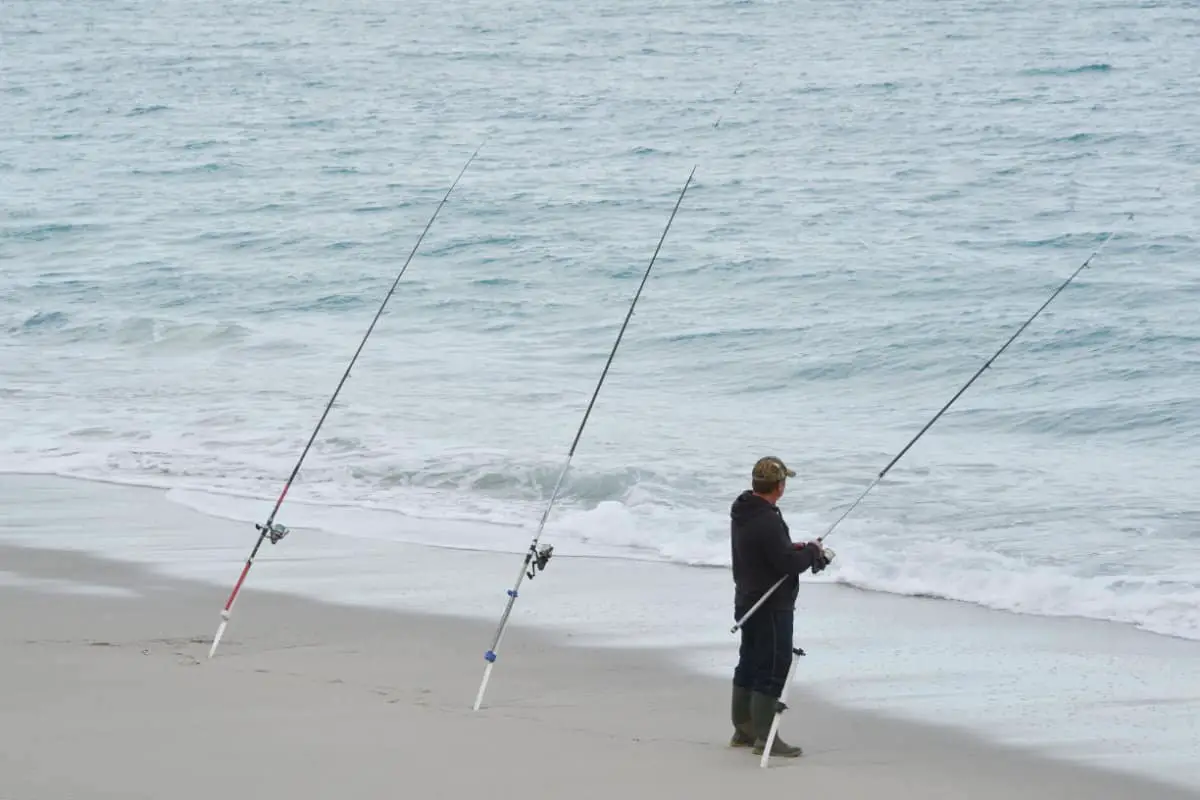Choosing a rod size that suits your specific surf fishing needs is one of the most challenging things you’ll have to do at your local tackle shop. That’s because surf rods usually come in varying lengths, and each size has unique advantages and disadvantages when used in particular surf fishing conditions.
Depending on body structure, the best rod size for surf fishing is between 9ft and 12ft long. For most anglers, this size provides long casting distances, is comfortable to use, and is more ideal for overpowering fighting fish.
In this article, we’ll discuss in great detail the various aspects of rod size and the ideal surf rod length for different circumstances to help you choose the best fit for your fishing needs. Let’s get right to it, shall we?
The Basics of Surf Rod Length
For many surf anglers, the general rule of thumb is that a longer surf rod is better. This is primarily based on the idea that fish are typically found near the sandbars’ borders, which is usually about 50-150 yards off the shoreline.
A longer surf rod![]() would, thus, enable you to reach the fish almost effortlessly. So, does this mean longer is always better when choosing rod size for surf fishing
would, thus, enable you to reach the fish almost effortlessly. So, does this mean longer is always better when choosing rod size for surf fishing![]() ? Not necessarily.
? Not necessarily.
To clarify, let’s take a look at the advantages and disadvantages of long surf fishing rods![]() compared to their shorter counterparts.
compared to their shorter counterparts.
First, the good:
Long Surf Rods Help Anglers Avoid Obstacles
Long rods give anglers a better chance of avoiding obstacles when retrieving their lure. So if you’ve been struggling to keep your line away from the Oyster encrusted rocks near the shoreline, or weed cover that keeps interfering with your lure, a surf rod with a length of 12 ft. might help.
Longer surf rods also allow anglers to avoid interference from crashing ocean waves, which may cause you to lose your lure and compromise your line’s sensitivity.
Long Surf Rods Help Cushion the Leader Against Sudden Fish Surges
This is because they’re typically more progressive and parabolic, and the curve generated by the pressure from the weight of the catch helps prevent the rod from breaking when retrieving big, fighting fish.
This makes long surf rods ideal for those intense fights you might find yourself in when pulling larger fish to the shoreline.
Long Surf Rods Provide Better Control of the Catch
Thanks to their long handles, long surf rods allow anglers to exert more pressure on the fish during those big fish fights. If you didn’t know, your hand and the fishing rod form a lever![]() when fishing.
when fishing.
The fish is the load, and the rod represents the beam. The prop is the bottom part of the rod’s handle, while the front hand you use to reel in the fish acts as the force.
Now, if you’re familiar with a lever’s mechanics, shifting the fulcrum has an impact on the amount of force exerted on the load.
With a longer handle in a surf fishing rod, the fulcrum shifts towards the tip of the rod, which amplifies the amount of force you can exert on it.
That means you get more power and control over the catch, which is critical during those big fights. A short handle would counteract this phenomenon, giving the fish a better chance of fighting.
Long Surf Rods Are More Adjustable
Long rods allow anglers to adjust the shock leader to a greater extent. Located between the lure and the rod tip, a shock leader cushions against the stress caused by heavy sinkers when throwing your bait.
Lengthening it results in smooth and longer casting distances and increased lure speed, and such adjustability is more possible with a shorter rod.
Long Surf Rods Allow Faster and Longer-Distance Casting
Long surf rods generate more rod tip speed than their short counterparts. That’s because long surf rods typically have longer casting arcs than short rods, resulting in higher line speed.
In surf fishing, a higher line speed means faster and longer-distance casting.
Then, the bad:
- Long surf fishing rods are generally pricier than their short counterparts.
- Long rods are heavy. Regardless of your physical capabilities, casting all day with a 12ft. (3.7m) surf rod will be more tiresome than casting with a 7ft. (2.1m) short surf rod.
- Long surf rods are harder to maneuver than short rods, especially in tight angles.
- Long surf rods are harder to travel with than short rods. Due to their length, extra-long surf rods may be more cumbersome to carry around.
The Minimum Rod Length for Surf Fishing
For most anglers, 9ft is the bare minimum for a surf fishing rod. That’s because this length gives you total control over the other end of the line and enhances your ability to fight large fish and effectively hookset your surf rod.
It also enables you to cast way past the sandbars and into deeper waters, where larger fish typically thrive. While going shorter than 9 feet might work, it can also end up being counterproductive.
This is because a surf rod that’s less than nine feet will make hook setting very difficult (especially in terrible surf conditions) and compromise your ability to reel in enormous, fighting fish.
Additionally, a surf rod shorter than 9 feet won’t allow you to fish past the second sandbar. That means your casting distance will be very limited, and you’ll struggle to catch any fish at all when the beach is crowded.
Short rods also aren’t good when you’re fishing in an area prone to snags because they provide limited power and control.
Concerning sea fishing, a snag refers to instances when some parts of your rig get stuck on underwater obstacles, thus preventing you from reeling in the rig.
It’s one of the most frustrating situations sea fishing anglers have to deal with because it often leads to losing numerous rigs in a single session, and the replacement costs can pile up over time.
So if you were looking for a bottom line in terms of rod length, it’s about nine feet. A rod with at least that length will allow you to:
- cast faster and further away from the shore (where fish flourish),
- change your bait easily, and
- Have better control of the line.
The Optimum Rod Length for Surf Fishing

Most anglers find 9 ft. to 12 ft. to be the optimal length for a surf rod. This size gives most adult anglers great casting distance, a better chance of overpowering enormous fish, and an easier way to hookset their surf rods without compromising comfort.
With that said, if your body stature allows you to comfortably fish with a 12ft surf rod or even longer, then go for it because the extra casting distance will come in handy, especially when fishing in a crowded beach.
A longer surf may also be ideal if you’re targeting larger fish such as Tuna. That’s because such fish species are usually found deeper into the ocean (at least 200 yards from the shoreline), and you can only cast that far with a long rod.
Ultimately, any surf rod that ranges between 9ft to 11ft. is ideal for surf fishing![]() . However, you can decide to go with either a shorter or longer surf rod depending on your comfortable and unique fishing conditions.
. However, you can decide to go with either a shorter or longer surf rod depending on your comfortable and unique fishing conditions.
However, if you choose a short rod, you’ll have to make do with the shorter casting distance. Fortunately, there are a few things you can do to cast further with a short rod:
Add More Casting Weight
Increasing your casting weight makes your rod more stable, which comes in handy, especially if you often fish in difficult surf conditions![]() .
.
It also allows you to achieve longer casting distances because the extra weight increases your line’s speed, which helps propel your bait further.
But while increasing your casting weight allows you to cast longer distances, there are some disadvantages to such a move.
Increasing your weight makes your surf rod heavier, meaning it’ll be tiresome to cast with all day long.
Secondly, a large lead might get caught between obstacles in underwater terrain, which may lose some parts of your fishing gear.
Using a heavy sinker may also make hook setting and controlling fighting fish difficult.
That’s because heavy sinkers tend to absorb most of the energy transmitted to the line, which compromises the amount of control you have over your catch and makes it very difficult to overpower larger fish.
Use a Thinner Line
Using a thinner line is another creative way to compensate for a short rod. A thinner line is less impacted by air resistance, giving it more speed than a thicker one.
Since more line speed results in longer casting distance, you can compensate for one of the biggest issues with short rods by simply switching to a thinner line.
However, there’s a trade-off: While a thinner line can help you cast further, using it for fishing in a seabed with obstacles or for fighting an enormous catch might cause it to break because thinner lines have less tensile strength.
But there’s a way to get around this issue: opting for a braided line![]() . Typically, these are thinner than traditional lines but still have great tensile strength.
. Typically, these are thinner than traditional lines but still have great tensile strength.
That gives them the perfect combination of line speed and tensile strength, meaning you can use them to enhance a short rod’s casting distance without having to worry about breakage.
Use a Slow Action Rod
Even though slow action surf rods aren’t necessarily the best option for surf fishing, they are great for long-distance casting.
That’s because the entire rod of a slow action surf rod bends when loading, and as a result, the energy you exert as an angler during the loading stage is somewhat “amplified” by the rod’s arch.
But while this effect allows you to cast longer distances, slow action surf rods typically are less sensitive to fish bites, which makes them not-so-great at hooking smaller fish.
If this doesn’t bother you, switching to a slow action rod can help you realize longer casting distances with a short rod.
Cast Into the Beach Channels
Casting towards the beach channel’s direction may help you realize a longer casting distance with a short rod because the ocean currents will likely pull your bait towards the sea.
The added advantage of this type of casting is that outgoing ocean currents tend to deposit nutrients and food along the channel, which attracts big fish![]() looking to feed.
looking to feed.
This means that casting into the channels gives you the best chance of bagging a large catch even with a short rod.
Fish Around a Rising Tide
During a rising tide, water moves more than usual, and this encourages fish to feed. In one study![]() , researchers set out to investigate the effect of tides and turbidity
, researchers set out to investigate the effect of tides and turbidity![]() on fish behavior in Kuwait Bay.
on fish behavior in Kuwait Bay.
They found that fish tend to form shoals at the edge of a rising tide both day and night, and that fishing on the beach during a rising tide results in much higher catches.
In addition to attracting more fish, a rising tide moves your bait differently. Combined, these conditions make a rising tide the perfect opportunity to ambush them as they swim towards the shoreline to feed.
Since the catch will already be close to the shoreline, fishing during a rising tide won’t require long casting distance.
That means you can comfortably use a short rod in a rising tide and take advantage of its easy maneuverability, affordability, and portability.
Fish at Night
Fishing at night gives you a better chance of bagging bigger fish because this is when large predatory fish hunt near the shoreline, where their prey is more visible.
This is particularly true if you’re trying to catch sailfish because they typically hunt in groups as a means to make their attacks unpredictable to the prey
Similarly, small fish tend to feed more when it’s dark, not to mention that the lack of light makes it almost impossible for them to see your line and hook.
These conditions combine to make fish more susceptible to take the bait at night, which increases your chances of landing a bigger catch.
They also bring the fish closer to the shoreline, thus eliminating the need for a long cast.
That means you can use a short rod for fishing at night and land just as much catch as you would when using a long one.
Use Simple Rigs
Air friction usually reduces your line speed and, as a result, limits your casting distance. If you use a rig with too many things attached, it’ll increase air resistance when launching the line and result in a shorter casting distance.
On the other hand, a simple rig without too many extensions and hooks will be more streamlined. That means it’ll experience less air resistance when you launch the line, which will increase your casting distance.
What Size Rod Should I Pair with the Best Size Reel for Surf Fishing?
When deciding on the best size reel for surf fishing, it’s crucial to pair it with the right size rod. For surf fishing, a longer rod, such as 10-12 feet, is typically recommended to help cast bait further into the surf. This will complement the best size reel for surf fishing and improve casting distance and overall fishing performance.
How to Choose the Best Rod Size for Your Specific Fishing Conditions

Ultimately, choosing the perfect rod size will depend on your specific fishing conditions and capabilities; and no one knows those better than you.
That said, there are some important considerations you should keep in mind when making that choice to land as close to perfect as possible.
These include:
Your Skill Level
If you’re a new angler, you might want to consider going for a shorter surf rod (between 8ft and 10ft.) Typically, rods with this kind of length are easy to handle and maneuver. They also have great sensitivity, meaning they’ll allow you to detect even the slightest of fish bites.
Anything longer than 10ft. will be difficult to maneuver because it’ll be too heavy for a novice angler.
On the other end of the spectrum, anything shorter than 8ft will have too short casting distance, and you might not be able to get your bait past the second sandbar with such a rod.
Hook Setting Leverage
Long surf fishing rods![]() offer you more leverage on the hook set than short ones. That’s because a long rod takes more line when swinging, which gives you better leverage when battling a big fish than you’d have when using a shorter rod
offer you more leverage on the hook set than short ones. That’s because a long rod takes more line when swinging, which gives you better leverage when battling a big fish than you’d have when using a shorter rod![]() .
.
Casting Accuracy
Short surf rods allow you to cast with better accuracy than long ones because they’re more maneuverable and easier to control. They’re also easier to get in motion and load for casting.
If you have to choose based on accuracy alone, think about where you fish. If your fishing conditions call for short and precise casts, you’ll be better off with a surf rod shorter than 9 feet (2.7m).
But if your situation doesn’t require pinpoint accuracy, you can go longer to maximize casting distance.
Casting Distance
By now, you probably know that longer is better when it comes to casting distance. Long surf fishing rods are ideal for long-distance casting![]() because their length allows you to maximize the velocity of the rod tip, and as a result, they propel your bait further into the ocean.
because their length allows you to maximize the velocity of the rod tip, and as a result, they propel your bait further into the ocean.
Your Physique
It’s also important to choose the size of your rod based on your physical attributes. If you’re short in stature, a shorter surf rod may be more ideal because it will be easier to handle than a longer one. Similarly, a tall angler will find it easier to control a long surf rod than a short one.
Summing Up
While longer is often touted as better when it comes to surf fishing rods, this isn’t always the case. Depending on the demands of your fishing conditions and your capabilities, the ideal length for you might be somewhere between 9ft and 11ft.
You can zero in on a more precise length and choose the best option for your specific fishing needs by considering factors such as:
- your skill level
- hook setting leverage
- casting accuracy
- casting distance, and
- Your physical attributes.

